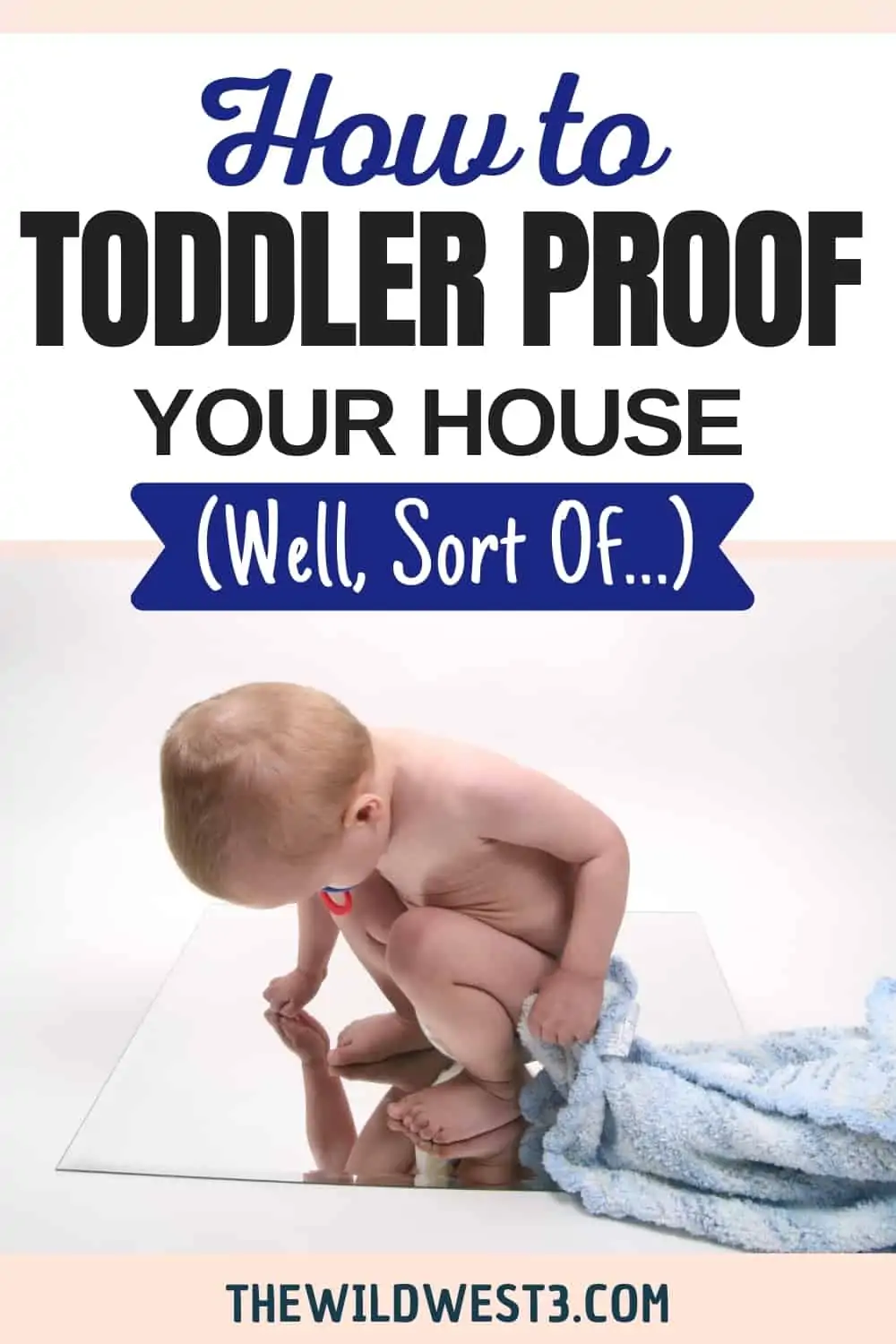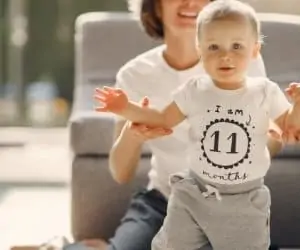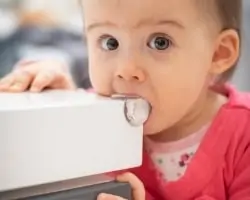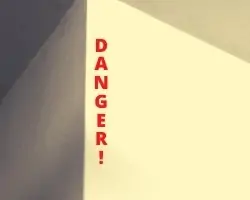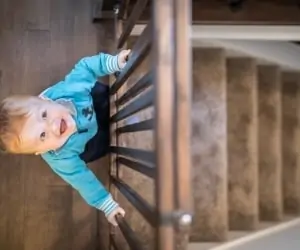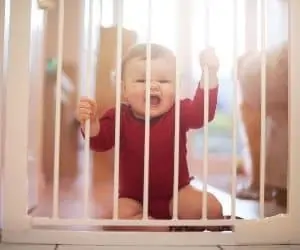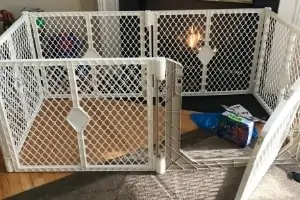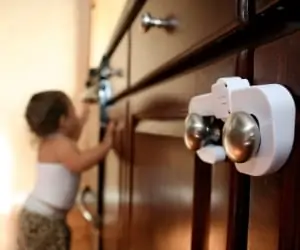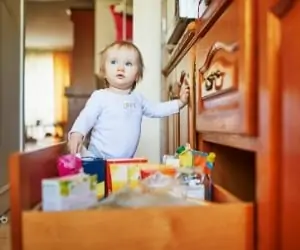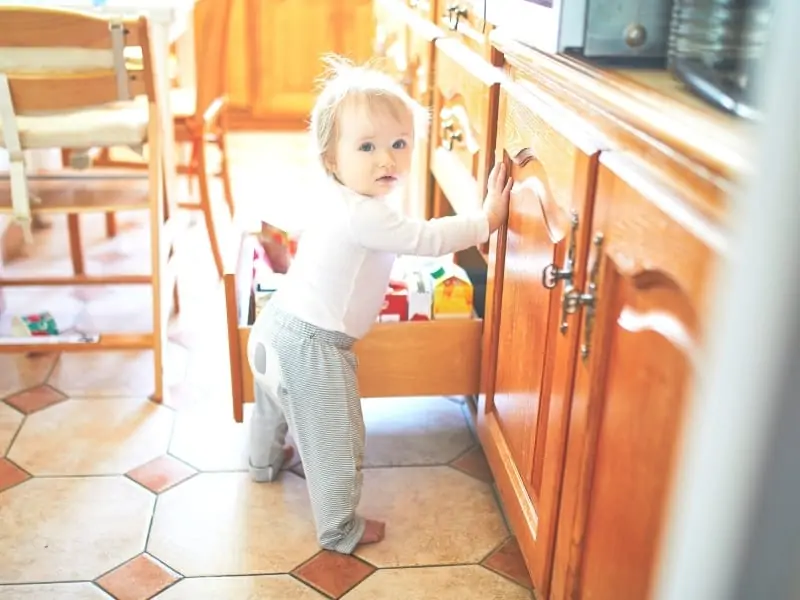
If you’ve ever tried toddler proofing your home in any way, you already know that the struggle is SO real. No matter how hard you try to childproof your house (or baby proof it, or wild-maniac-proof it, for that matter), you quickly discover that it isn’t enough. You need more baby gates, more corner protectors, more more more — and possibly a magical forcefield — to contain your toddler.
Why is it so hard to toddler proof a room, or even a section of a room?!
I think part of the problem is we underestimate toddlers.
A toddler doesn’t seem that far removed from the sweet, snuggly baby you brought home. After all, it wasn’t too many months ago that your baby was just beginning to crawl. At that point, you had already childproofed your house (or so you thought).
You were probably cheering excitedly as that crawling baby went on to take his or her first steps.
Aww, yay! So cute! Good job, baby!
That’s because you had no idea.
I’m approaching my fourth round of toddlerhood and all I can say is: I am no longer encouraging walking like I used to.
I mean sure, those early steps are precious and adorable. But there’s still a liiiiiiiittle piece of me that wants to push him back down and say “NO!” so my baby will stay minimally mobile for longer.
(Before you panic, obviously I don’t push him down, I’m just saying… the thought has crossed my mind.)
Because once that toddler is bee-bopping around on two legs, no amount of toddler proofing is going to contain them!
Your toddler has leveled-up and now your childproofing skills have to level up with them.
In that vein, I really struggled with the title of this article.
I started out with “How to toddler proof your home,” but that didn’t seem quite accurate. I also seriously considered “Innovative ways my toddler tries to die,” but I was afraid that might scare off too many parents. I decided to strike a balance between the two and voila! Here we are!
So when it comes to toddler proofing your home, what do you need to know?
Well, first, you need to understand that toddlers are way more innovative than we give them credit for.
Parents and caregivers are constantly underestimating the toddlers in their charge. Honestly, it reminds me of the scene in Jurassic Park where the raptor traps the Australian (I think?) guy. He knows he’s been caught and, right before he’s eaten, all he can say, with even a bit of marvel, is “Clever girl!”
Toddlers are so clever, so creative, that as soon as you successfully death-proof, oh I’m sorry, toddler proof one thing, they’re already onto the next. The house is essentially a buffet of danger to a fully mobile child.
Basically, no matter how well you think you’ve toddler proofed a room, they still can’t be left alone in it. Toddlerhood is the stage where parents learn they need to take their bathroom trips with lightning speed — or with their toddler’s company.
Because in your absence, however brief, your child will either find a way around your safeguards or, if they can’t, they’ll turn their attention to something less protected and try to harm themselves there instead.
Speaking of well protected…
To effectively toddler proof, you need to reevaluate the items that you consider safe.
Because the fact is, once you have a toddler, nothing is safe anymore.
Parents typically childproof their homes by focusing on the main dangers they see: sharp corners, cords, electrical outlets — and sure, those can be important.
But the real problem comes when your toddler turns seemingly benign household items into deadly weapons.
The bottom of your couch, where the upholstery is wearing thin? Underneath it is a sharp little staple. That spot on your couch has been wearing out for over a decade and you’ve never noticed it. Yet somehow, your toddler manages to find it with their finger EVERY. TIME.
The wooden end table, the one you put one of those little clever corner-protectors on?
What about the rest of the table? All of a sudden, you teething toddler is GNAWING ON THE ACTUAL TABLE ITSELF like a rabid beaver and choking on the wooden splinters. They don’t make a childproofing gadget for that!
What about the corner of the wall? No, not the corners of things, where you can attach those cushy little protectors. I’m talking about the corner of an entire wall itself.
Somehow, whenever my toddlers seems to lose their balance, it is always within a few-inch-radius of the corner of a wall. This allows them to wipe out and smack their heads regularly.
(In fairness to my children, they get this from their father. Hubby got a set of stitches courtesy of a wall edge like this in college. Of course, there was booze involved in that, but I suppose that’s neither here nor there…)
The only childproofing option I can think of for a wall like this is to actually bubble wrap the toddler.
And don’t even get me started on siblings!
Older siblings are pretty much walking death traps to toddlers (and babies!). Sometimes, it’s on purpose (sibling rivalry is for real, friends). More often than not though, their deadliness comes in the form of “helping”
God bless and keep my youngest child when one of his older brothers tries to “help” him. His life is probably never in greater jeopardy than at those moments.
Some of the best toddler proofing you can do for your child is just to keep a close eye on the siblings AND THEIR STUFF. Marbles and Legos: two things older siblings love that a baby or toddler can choke on faster than greased lightning.
The upside to the tiny Legos? When your little one gets a hold of them, many of them, AHEM, “pass” without incident. I’ll spare you any additional details.
So what ARE the right gadgets to toddler proof your home?
It wouldn’t be cool for me to leave you with nothing but doom and gloom. YES, toddlers are inherently dangerous little people. They are walking instruments of destruction — to themselves and everything in their wake (that’s why God makes them so cute).
Still, there are things you can do to make the toddler stage a little safer.
First, some good baby gates (or in this case, I guess, “toddler gates”)
If you didn’t bust out the baby gates when your baby started crawling, you’re definitely going to want them once your toddler is cruising around.
Gates for stairs are a must, of course, but you may also want gates to keep your toddler out of any rooms that are just off limits.
Maybe you have fragile things in there.
Maybe you have deadly things in there.
Maybe you just want one room where your things are not consistently ransacked!
Whatever the reason, baby gates are clutch in these situations.
If you have a really open floor plan, a traditional baby gate may not be enough for you. In that case, you may want to consider one of these extra wide options.
We have what my husband twistedly dubs The Baby Octagon because it looks like The Octagon from the 1980s martial arts fighting gigs.
You can stretch the gate out wide so it blocks off an entire room, or you can leave it closed like a little gated toddler play pen (a la The Octagon). Ours is currently functioning as both a playpen and a gas fireplace-blocker. (This one is super nice, but pricy; this one is more like ours and much more reasonably priced.)
GET THE CABINET LOCKS
This is the one thing, aside from the baby gate, I couldn’t live without.
The magnetic locks are fantastic for keeping little hands out of dangerous stuff. We use them for under the bathroom cabinets, kitchen sink, and a few kitchen cabinets with sharp/fragile stuff. Just make sure you get an extra pack of keys (or a few extra packs, if you’re disorganized like me–fortunately, the magnetic keys are interchangeable!).
If you really don’t want to drill into your cabinets to mount the locks, I understand. Honestly though? You can’t tell from the outside and I’ve never, as a homebuyer or as a home-liver, thought,
“Gee, I wish there weren’t these two small holes on the inside of my cabinet where I never, ever look.”
That said, you can always use a hair tie, rubber band, or one of these plastic things to secure side-by-side cabinets. Still, I find nothing works as well as the magnetic locks you drill into the cabinets.
It’s also nice to leave one or two cabinets with toddler-friendly items for them to wreck. All my babies and toddlers have loved being able to go into the plastic cup cabinet and dump everything out.
They feel like they’re getting away with something, it’s harmless, and you can actually get a few minutes of peace to sit down if you play your cabinet cards right.
Go ahead and get the corner protectors
As I said earlier, they won’t protect your toddler from hurting themselves on all the other sharp-ish things that aren’t corners, but at least these protectors can knock a few sharp items off the list.
You may want to try a few different types because some stay on better than others (and it tends to vary based on what you’re attaching it to, not the protectors themselves). Certain ones just fit some furniture better than others.
What about outlet covers?
Well, let me start by saying I’m not an expert and you do you, boo-boo. Copy me at your own risk.
But… the biggest risk I’ve found in our home when it comes to outlets is the actual outlet covers or plugs themselves.
Why? Because my babies and toddlers manage to remove them at light speed and then stick them immediately into their mouths.
We’ve had way more close-call choking incidents than we’ve had electric-shock-risk incidents. In other news, I don’t have any plans to enter my children into any World’s Smartest Babies contests anytime soon, but I digress…
In fact, an actual study was done on different types of outlet covers. The study found that the two outlet covers that were “more difficult” for kids still only took the children 38.9 seconds to remove.
I don’t mean to brag, but I’m sure my toddlers could remove them and be choking in half that time. So advanced… 🙂
But by all means, get them if you want them!
All toddlers have a knack for danger. Every day is Child Risk Mitigation 101.
Every time one of our kids has hit 12-13 months of age, my husband and I look at each other and say something along the lines of, “Holy crap, I forgot how ridiculous this stage is.” (This is usually just after one of us saves them from taking a flying leap/tumble off the back of the couch.)
And it is. It’s utterly ridiculous.
When God made toddlers, I wonder why He didn’t also give them six parents. I honestly think six is a reasonable number of adults who should be expected to share the supervision of ONE toddler.
When your toddler hits the less deadly age (usually somewhere between two and three), I think they should automatically power off so parents can nap and recover FOR A FULL YEAR from all the life-saving they’ve done. That would be the reasonable thing here.
Of course, some of you may have lucked out. Maybe you have the tame toddler who respects rules, boundaries, and has a heaping supply of common sense even at the ripe old age of 13 months.
May I suggest you quit while you’re ahead?
Lightning like that rarely strikes twice. If Child 1 is this way, Child 2 is likely to be — oh what does that popular meme say again?
Oh yeah– Child 2 is likely to be “a no-limit soldier who likes to slap,” so get ready!
If you enjoyed this post, you may also like:
Operation Sibling: How To Prepare Your Toddler For a New Baby
What is my Toddler Saying? A Hilarious Toddler Translation Guide
Hilariously Helpful Life Hacks for New Parents Baby Books SHOULD Include

